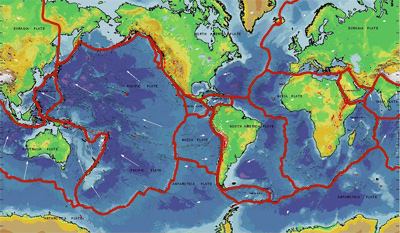This diagram shows evidence for seafloor spreading.
Click on image for full size
D. Roddy and LPI
Pacific Rim of Fire
The diagram shows a remarkable fact about the surface of the Earth. Around the rim of the Pacific Ocean are many volcanoes. The rim of the Pacific Ocean also is the scene of much earthquake activity.
These volcanoes are most typically found in the regions where subduction is taking place.
The ring of volcanoes around the Pacific Ocean is called the "Pacific Rim of Fire".
The diagram shown here also shows (in yellow) the boundaries of many of the Earth's surface plates.
You might also be interested in:

The main force that shapes our planet's surface over long amounts of time is the movement of Earth's outer layer by the process of plate tectonics. This picture shows how the rigid outer layer of the Earth,
...more
A new remotely operated vehicle (ROV) called Nereus has dived 10,902 meters, the deepest dive to date. The robot spent about 10 hours in the Mariana Trench, the deepest part of the ocean and the boundary
...more
Ash is made of millions of tiny fragments of rock and glass formed during a volcanic eruption. Volcanic ash particles are less than 2 mm in size and can be much smaller. Volcanic ash forms in several ways
...more
Cinder cones are simple volcanoes which have a bowl-shaped crater at the summit and only grow to about a thousand feet, the size of a hill. They usually are created of eruptions from a single opening,
...more
Lava can move in broad flat lava flows, or it can move through tight channels or tubes. Lava flows tend to cool quickly and flow slowly. The fastest lava outside of channels moves at about 6 mi/hr an easy
...more
Plates at our planet’s surface move because of the intense heat in the Earth’s core that causes molten rock in the mantle layer to move. It moves in a pattern called a convection cell that forms when
...more
Many kinds of surface features are clues that our lithosphere is sliding. Two types of features can form when plates move apart. At mid ocean ridges, the bottom of the sea splits apart and new crust is
...more















